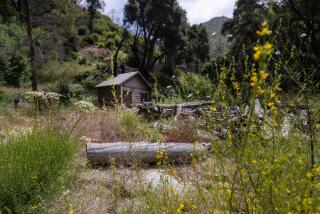Boy Scouts Bury the Campfire Hatchet : Nature: These days, not even the scouting manual recommends building a fire in the wilderness.
BEND, Ore. — The U.S. Forest Service wants people to forget some of the camping techniques they learned as youngsters.
And, recognizing that times have changed, the Boy Scouts have revised their handbook and are urging young campers to leave their hatchets at home.
Rangers such as Michelle Kaptur, who patrols the high wilderness of the Cascade Range, are telling campers that it is no longer good enough to leave a clean camp in the wilderness. The Forest Service wants you to leave no trace of a camp at all, especially not a ring of rocks where you built a fire.
“When you leave a fire ring, the next person says, ‘Hey! There’s a camp! Let’s use it!”’ Kaptur explained to a group of campers at Quinn Meadows outside Bend. “After 300 people use it, it’s not a wilderness any more.”
“There is this whole cultural image of what camping is,” she said in an interview. “In the new ‘Star Trek’ movie, there’s a scene where they’re sitting around a campfire. They had looked through the computer log to find out what camping is. And it’s exactly true. You have to have a fire ring. You have to have marshmallows. That’s all true.
“But it doesn’t work anymore. There’s too many of us for it to work.”
The urge to build a fire--what Kaptur calls the television of the wilderness--is so strong that the most popular wilderness areas of the Deschutes National Forest have run out of dead wood.
“People don’t realize that at ground level all those little twigs they use for fires have a purpose,” Kaptur said. “They (decompose and) feed the trees.”
The 10th edition of “The Official Boy Scout Handbook, due out in January,” for the first time advises young campers to cook on a stove rather than a fire and to leave their hatchets behind.
Since the first handbook came out in 1910, the book that has taught millions of Americans how to camp has described the joys of cooking over an open fire and using an ax.
“That’s when you’ll really feel yourself akin to the early American pioneers hewing their homes out of the wilderness,” the 1962 handbook reads.
The latest edition doesn’t even mention the Official Boy Scout Hand Axe, handbook editor J. D. Owen said from his office in Irving, Texas.
“In the old days, you could go pitch a camp anywhere and chop down trees to build pioneer projects, and nobody would care,” said Owen. “These days, they do care. High-impact techniques are not suitable anymore, and we don’t teach them.”
Robert C. Birkby, who wrote the new handbook, said the Boy Scouts want to influence campers.
“Here is a real opportunity to make a difference in the way that young people, future adults, view the environment in which they live and can take an active part in making some substantial changes in the quality of that environment,” Birkby said from his home in Seattle.
“When people think of scout camping now, I hope they will think of small, very environmentally aware groups that are able to go deep into the backcountry and leave no trace of their passing,” he said.
Cliff Blake, national coordinator for the Forest Service’s “No Trace” camping program, has the tough job of spreading the word with a meager budget and no cute animal symbol, such as Smokey the Bear or Woodsy Owl, to champion the cause.
Blake went to the Boy Scouts for help about five years ago and now counts on them to help him promote No Trace camping.
“We were talking about 18 million visitors to the national forest system back in 1946,” said Blake. “Now we are looking at 225 million per year doing their thing. The land hasn’t expanded any, but the people certainly have.”
More to Read
Sign up for The Wild
We’ll help you find the best places to hike, bike and run, as well as the perfect silent spots for meditation and yoga.
You may occasionally receive promotional content from the Los Angeles Times.





